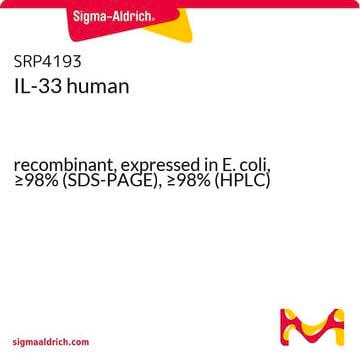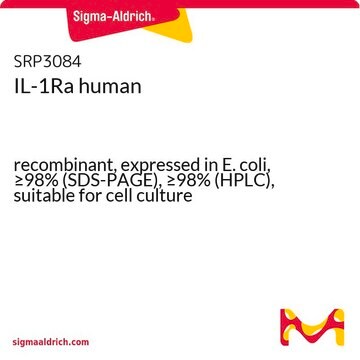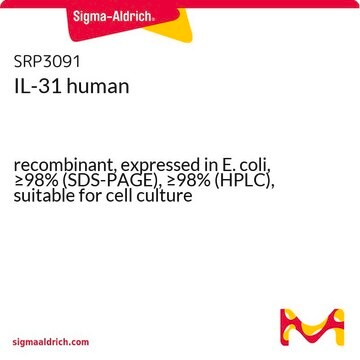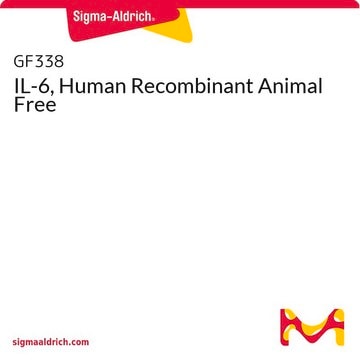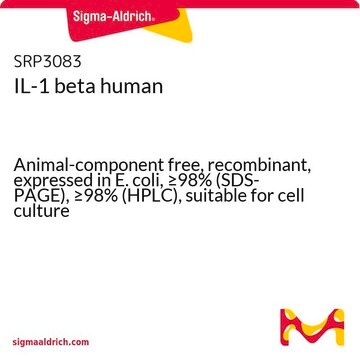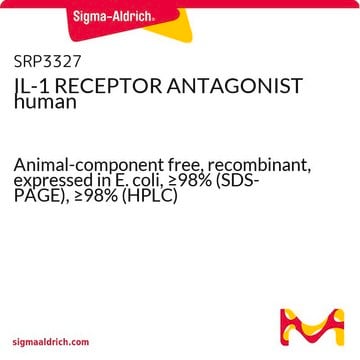SRP3275
IL-33 human
Animal-component free, recombinant, expressed in E. coli, ≥98% (SDS-PAGE), ≥98% (HPLC)
Synonym(s):
NF-HEV
Sign Into View Organizational & Contract Pricing
All Photos(1)
About This Item
UNSPSC Code:
12352202
NACRES:
NA.32
Recommended Products
biological source
human
recombinant
expressed in E. coli
Assay
≥98% (HPLC)
≥98% (SDS-PAGE)
form
lyophilized
potency
≥0.05 ng/mL ED50
mol wt
17.9 kDa
packaging
pkg of 10 μg
impurities
<0.1 EU/μg endotoxin, tested
color
white to off-white
UniProt accession no.
shipped in
wet ice
storage temp.
−20°C
Gene Information
human ... IL33(90865)
Related Categories
General description
It binds and signals through the IL-1RL1/ST2 receptor activating NF-kappaB and MAP kinases. IL-33 induces production of TH2 cell related cytokines, including IL-4, IL-5 and IL-13, and exerts multiple inflammation related bioactivities.
Biochem/physiol Actions
Human IL-33 is a proinflammatory protein that shares structural and functional characteristics with the IL-1 cytokine family. Recombinant human IL-33 is a 17.9 kDa protein containing 159 amino acid residues.
Physical form
Lyophilized from 10 mM Sodium Phosphate, pH 8.0 + 0.5 mM DTT.
Reconstitution
Centrifuge the vial prior to opening. Reconstitute in water to a concentration of 0.1-1.0 mg/mL. Do not vortex. This solution can be stored at 2-8°C for up to 1 week. For extended storage, it is recommended to further dilute in a buffer containing a carrier protein (example 0.1% BSA) and store in working aliquots at -20°C to -80°C.
Storage Class Code
10 - Combustible liquids
WGK
WGK 1
Flash Point(F)
Not applicable
Flash Point(C)
Not applicable
Certificates of Analysis (COA)
Search for Certificates of Analysis (COA) by entering the products Lot/Batch Number. Lot and Batch Numbers can be found on a product’s label following the words ‘Lot’ or ‘Batch’.
Already Own This Product?
Find documentation for the products that you have recently purchased in the Document Library.
Elizabeth A Oczypok et al.
The Journal of allergy and clinical immunology, 136(3), 747-756 (2015-05-02)
Single nucleotide polymorphisms in the human gene for the receptor for advanced glycation end-products (RAGE) are associated with an increased incidence of asthma. RAGE is highly expressed in the lung and has been reported to play a vital role in
Ying Lei et al.
PloS one, 10(7), e0133774-e0133774 (2015-07-28)
In several clinical and experimental studies IL-33 and its receptor have been found to play important roles in the development of asthma and allergic airway inflammation. We evaluated the effects of vaccination against IL-33 in a mouse model of airway
Jochen Schmitz et al.
Immunity, 23(5), 479-490 (2005-11-16)
Cytokines of the interleukin-1 (IL-1) family, such as IL-1 alpha/beta and IL-18, have important functions in host defense, immune regulation, and inflammation. Insight into their biological functions has led to novel therapeutic approaches to treat human inflammatory diseases. Within the
Rebecca L Maywald et al.
Proceedings of the National Academy of Sciences of the United States of America, 112(19), E2487-E2496 (2015-04-29)
Tumor epithelial cells develop within a microenvironment consisting of extracellular matrix, growth factors, and cytokines produced by nonepithelial stromal cells. In response to paracrine signals from tumor epithelia, stromal cells modify the microenvironment to promote tumor growth and metastasis. Here
Ilija Jeftic et al.
Molecular medicine (Cambridge, Mass.), 21, 453-465 (2015-05-29)
The importance of Galectin-3 (Gal-3) in obesity-associated liver pathology is incompletely defined. To dissect the role of Gal-3 in fibrotic nonalcoholic steatohepatitis (NASH), Gal-3-deficient (LGALS3(-/-)) and wild-type (LGALS3(+/+)) C57Bl/6 mice were placed on an obesogenic high fat diet (HFD, 60%
Our team of scientists has experience in all areas of research including Life Science, Material Science, Chemical Synthesis, Chromatography, Analytical and many others.
Contact Technical Service